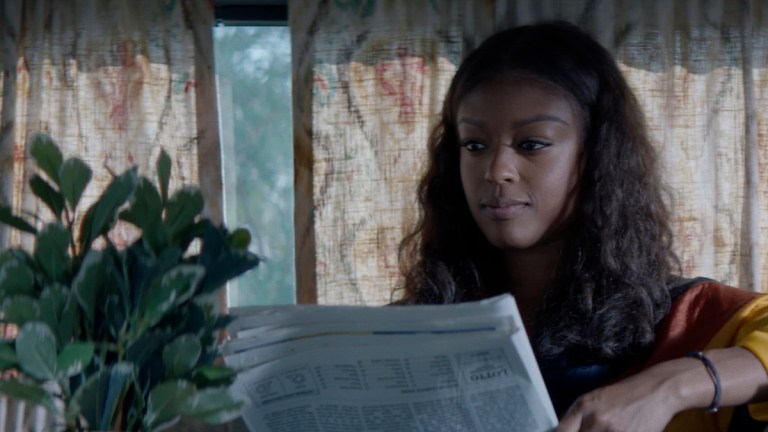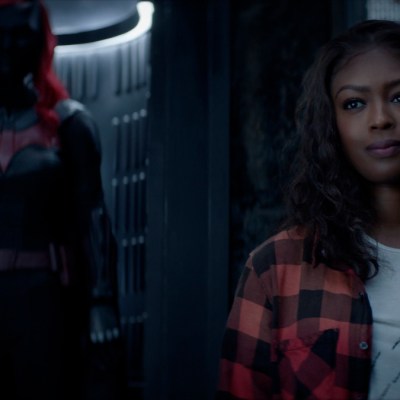Batwoman: How Housing and Homelessness Shape Ryan’s Heroism
Batwoman has intentionally pivoted to a different kind of superhero in a number of ways, and Ryan’s housing status is one of them.

From the very first promo, where we saw Kate Kane give first money and then her gold watch to a young woman panhandling, Batwoman has concerned itself with homelessness and housing. In Ryan Wilder (Javicia Leslie), however, Batwoman has a new protagonist with lived experience of homelessness. Unlike a lot of television shows that use homelessness as a shorthand to demonstrate that a main character is a good or bad person, Batwoman meaningfully incorporates Ryan’s housing struggles into her long-term character arc and how she approaches her time in the cowl.
In that first teaser back before season 1 premiered, the audience was meant to learn both that Kate Kane was incredibly wealthy and that, unlike the jerky anonymous member of the Crows, she actually cared about doing something to change Gotham’s notoriously tough streets, and not just in a “lock ‘em up” kind of way. Thanks to her one-time girlfriend, Reagan, as the first season unfolded, heiress Kate became more aware of how gentrification and the lack of affordable housing was squeezing low-income Gothamites out of their own city.
At a press event before the start of season 2, showrunner Caroline Dries shared that incorporating housing policy wasn’t some kind of strategic goal, but she did always see Gotham as a kind of Los Angeles 2.0 – except even bleaker.
“From a creative point of view, I think that happened a little bit subconsciously. Living in LA the homeless population has just exploded in the last seven years or so,” Dries says. “It’s everywhere you look, and it’s such a huge problem, and it feels like there’s really no solution to it.”
For Dries, fiction allowed her a measure of wishful thinking: “When I was offered the opportunity to write Batwoman and to write Kate Kane, it seemed like: Oh, at least maybe there’s some way that I can have control over this seemingly like endless pandemic of homelessness in our city.”
After hearing about Reagan’s grandmother’s housing struggles – and how common they are across Gotham – Kate went on to form Gotham Pride Real Estate, her way of improving her city by day, under her own name. Kate bought and renovated apartment buildings and rented them at reasonable rates as a way to lock in long-term affordable housing. In some cases, Gotham Pride bought buildings in Gotham’s wealthiest neighborhoods and still rented them at very low rents, pushing back against the extreme wealth segregation that the show has hinted at and that is a reality for much of America.
As Dries says, “It was just like a little bit of hopefulness that I was trying to put out into the world.”
Kate also created The Hold Up, an LGBTQ bar that seems to cater specifically to the sapphic set, which is its own form of business activism. Nationwide, lesbian and queer bars for marginalized genders are an endangered species. As we saw when Kate and Sophie got kicked out of Allesandro’s for holding hands, having spaces where queer folks can simply exist safely and openly isn’t a given, so creating one matters. By owning real estate and using it to make safe, affordable spaces for vulnerable populations to live or to gather socially, Kate Kane has leveraged her wealth to help various communities reclaim Gotham so it can belong to everyone, not just the wealthy few.
With Ryan Wilder stepping into the spotlight for the second season, housing takes on more urgency. The premiere showed how squatters from Alice’s Wonderland Gang killed Ryan’s mother in her own apartment. That made Ryan an orphan and forced her out on the street. She’s been living in her van, and as of the end of the second episode, our Batwoman is still marginally housed, meaning that while she can stay in her van, that’s neither a permanent solution nor is it a sufficient one.
How many other superheroes have experienced homelessness in the present tense – and not as part of going undercover or in some kind of training exercise, but because they literally had nowhere else to go? Dries intentionally pivoted to a different kind of Batwoman in a number of ways, and Ryan’s housing status is one of them.
“With Ryan, it was part of the overarching goal that I had in creating a character who is nothing like Kate Kane, and Kate is a billionaire who never will have to worry about being homeless, she can work to help homelessness,” Dries says. “So it just made sense to me that in creating Kate’s foil, more or less, that maybe Ryan came from a more troubled background where she was part of this problem in her city.”
While Kate was an excellent hero for her city, in many ways she was still a privileged one. Ryan’s experiences, including her time navigating what it means to be unhoused, open up a whole host of possibilities for the ways in which her Batwoman could best serve the people who need her most, because she knows their needs acutely. A common critique of Batman is that many of the people he physically brutalizes are in need of mental health services and/or are at the mercy of an unjust criminal legal system and a city with no social safety net that has pushed them toward a life of crime. Just as Kate’s queer Batwoman before her, Ryan’s Batwoman poses the question: What does a radically reimagined Batwoman look like? How can she better serve the people of Gotham with the greatest need, while pushing back against the authoritarianism of the Crows and the demands of the wealthy elites who hire them?
Toward the end of the second episode, “Prior Criminal History,” Luke Fox offers Ryan a warehouse to draw the poisonous bats away and then detonate a bomb to take them out, away from innocent civilians. On the city plans he has access to back in the Bat cave, the warehouse looks abandoned. But Ryan does a double-take and tells him no, they have to find somewhere else – that’s actually a homeless encampment. Luke immediately starts looking for a new locale, and Ryan comes up with the idea to use the Crows Security bus, resulting in a great little set piece.
It may seem like a small moment, but this demonstration of how Ryan’s knowledge and therefore actions as Batwoman would be completely different is spot-on and an absolute game-changer. In every city in America, there’s a complex infrastructure that people who are currently homeless or marginally housed must navigate in order to get through their day to day. Just out of sight from housed people, there are encampments, shelters, and an array of social services all requiring completely different paperwork, hours, and counselors. Ryan would know the safest places to park her van, the hours for the best soup kitchens, where the women-only shelters are, and the places that stay open latest, in case it gets so cold late at night that she has to go in.
Just before she detonates the bomb, Ryan sees a young woman sheltering in a tent nearby. She runs over and shields them both with her cape. Afterwards when the coast is clear, the young woman looks up at Ryan in the batsuit with admiration.
“Batwoman?”
“Oh no, not really,” Ryan says, hesitantly.
“Well,” says the young woman, “you are to me.”
Just as Kate Kane helped many more people see themselves on screen as heroes, Ryan Wilder is now doing the same thing, in-world, and I suspect, irl. For Black women and queer Black folks, but also for anyone who has experienced homelessness. For the people who have couch-surfed for months on end, lived in their cars, or who struggle to keep their head above water because of a record – even if it’s one they got unjustly, like Ryan.
Leslie speaks about how with the character of Ryan, the show gets to bring in a firsthand story to show what it’s like to actually live through these experiences, rather than having characters observe or comment on them from afar.
“I think that what’s really dope about what we’re doing this season is you get to see Ryan’s story and how she ends up where she is,” Leslie says. “And a lot of it is just, it’s the system and being lost in the system and not having support in the system.”
Batwoman has long taken on serious social issues that other superhero shows lack the moral heft to consider, whether that means police corruption, racism within the legal system, American’s broken and inadequate healthcare system, or discrimination against LGBTQ people. The show’s diverse cast of characters speak about these issues firsthand, and Ryan Wilder is no exception. Her backstory as someone who has struggled with housing insecurity isn’t a throwaway line but rather a current aspect of her life that sets the tone for who this new Batwoman is, and how the show will be moving forward.
Subscribe to Den of Geek magazine for FREE right here!

